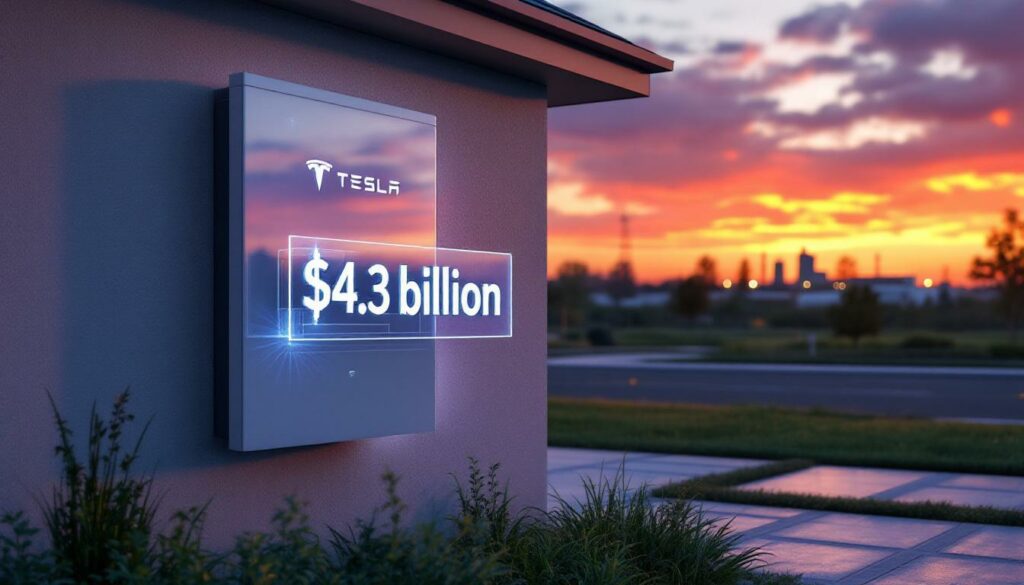Understanding Tesla's Strategic LFP Battery Partnership with LG Energy Solution
Tesla and LG Energy Solution (LGES) have formed a groundbreaking partnership that signals a major shift in North America's battery metals landscape. This strategic alliance focuses specifically on lithium iron phosphate (LFP) battery technology and represents a significant step in Tesla's efforts to diversify its supply chain while reducing dependency on imports.
What Is the Tesla-LGES Battery Deal Worth?
The Multi-Billion Dollar Agreement
The partnership between Tesla and LG Energy Solution involves a substantial $4.3 billion supply contract (approximately €3.7 billion). This three-year agreement spans from 2027 through 2030 and focuses exclusively on LFP battery cells, which will be manufactured at LGES's Michigan facility.
Industry analysts note that these cells are primarily intended for Tesla's stationary energy storage systems rather than electric vehicles. This strategic decision allows Tesla to optimize its battery chemistry usage based on specific application requirements.
"This represents one of the largest domestic battery supply deals in the U.S. to date, signaling a significant shift toward localizing critical supply chains," notes battery industry expert Sarah Chen, who studies supply chain resilience.
Strategic Timing and Market Positioning
The timing of this contract announcement is particularly noteworthy, coming shortly after Tesla's Q2/2025 earnings report. The agreement positions both companies advantageously in the rapidly growing energy storage market, which is projected to expand at a CAGR of 20-25% through 2030 according to Bloomberg New Energy Finance.
This partnership aligns perfectly with the broader industry trend toward localized supply chains in North America, driven by both economic considerations and policy incentives. By securing a domestic supply of LFP cells, Tesla gains greater control over a critical component of its energy storage business.
Why Is Tesla Shifting to US-Made LFP Batteries?
Reducing Dependency on Chinese Imports
A key driver behind this partnership is Tesla's strategic move to reduce its reliance on Chinese battery imports. Rising tariffs impact market conditions and have created significant cost uncertainties for the company. During a recent earnings call, Tesla CFO Vaibhav Taneja specifically highlighted how these tariffs have disproportionately impacted Tesla's energy business.
The challenges extend beyond just pricing, affecting:
- Supply chain stability during periods of geopolitical tension
- Logistics complexity and shipping delays
- Inventory management challenges
- Regulatory compliance costs
- Carbon footprint associated with long-distance transportation
Tesla's move toward domestic production offers greater control over these variables while reducing vulnerability to international trade disputes.
Economic and Manufacturing Advantages
Localized production brings numerous economic advantages that strengthen Tesla's competitive position:
- Reduced shipping costs – Eliminating transoceanic shipping can reduce per-unit costs by 3-5%
- Lower carbon footprint – Aligns with Tesla's sustainability mission
- Potential qualification for domestic content incentives – Including tax credits under the Inflation Reduction Act
- Improved inventory management – Reducing lead times from months to weeks
- Job creation – Supporting the domestic battery manufacturing ecosystem
The Michigan production facility is expected to incorporate state-of-the-art manufacturing techniques, potentially including LGES's most advanced cell production technologies.
How Does This Fit Into Tesla's Broader Battery Strategy?
Diversification of Battery Supply Sources
This partnership represents just one component of Tesla's comprehensive battery strategy. The company is actively developing multiple supply channels simultaneously, including:
- A US-based lithium refinery expected to come online by the end of 2025
- In-house LFP cell production planned to begin in 2025
- Continued relationships with other suppliers including CATL and BYD
- Research into next-generation battery chemistries
This diversified approach provides Tesla with greater supply security while allowing the company to leverage specific supplier strengths for different applications.
Technology-Specific Applications
Tesla's battery strategy involves matching specific battery chemistries to their ideal applications:
| Battery Chemistry | Primary Application | Key Advantages |
|---|---|---|
| LFP (Iron-based) | Stationary storage, standard range EVs | Lower cost, longer cycle life, improved safety |
| NMC (Nickel-based) | High-performance EVs, long-range applications | Higher energy density, better cold-weather performance |
| 4680 (In-house) | Structural battery packs, performance vehicles | Thermal efficiency, manufacturing simplicity |
Standard versions of the Model 3 and Model Y already utilize LFP technology, demonstrating Tesla's comfort with this chemistry for applications where ultimate energy density is less critical. For stationary storage applications like Powerwall and Megapack, the focus shifts to cost-effectiveness and durability—areas where LFP excels.
What Makes LFP Batteries Ideal for Energy Storage?
Technical Advantages for Stationary Applications
LFP battery chemistry offers several compelling technical advantages for stationary storage applications:
- Superior cycle life – LFP cells typically achieve 3,000-6,000 cycles compared to 1,000-2,000 for consumer-grade NMC
- Enhanced safety profile – Significantly reduced thermal runaway risks due to stronger oxygen bonds in the cathode structure
- Greater temperature stability – LFP cells maintain performance across a wider operating temperature range
- Longer calendar life – LFP cells can retain 80% capacity after 10+ years in ideal conditions
- Less susceptibility to thermal events – Critical for large-scale installations where safety is paramount
Dr. James Li, battery materials scientist, explains: "The phosphate bond in LFP cathodes creates an incredibly stable structure that resists oxygen release even under stress, dramatically improving safety compared to oxide-based cathodes."
Economic Considerations
The economic case for LFP in stationary applications is equally compelling:
- Cost advantage – LFP cells typically cost 20-30% less per kWh than NMC alternatives
- Raw material stability – Less exposure to volatile nickel and cobalt markets
- Lower insurance costs – Reduced fire risk translates to lower operational expenses
- Simplified thermal management – Less complex cooling systems required
- Higher depth-of-discharge tolerance – Can utilize more of the battery's capacity without degradation
These economic factors translate to a lower total cost of ownership over the product lifecycle, creating a significant competitive advantage in price-sensitive energy storage markets.
How Important Is Energy Storage to Tesla's Business?
Growing Revenue Contribution
Tesla's energy division, encompassing both storage and solar products, has become an increasingly significant part of the company's business:
- Now represents approximately 10% of Tesla's total revenue
- Reached 12.4% of company revenue in Q2/2025
- Achieved five consecutive quarters of growth in home battery installations
- Demonstrates less seasonality than the automotive segment
- Delivers strong and growing profit margins
While Tesla's automotive business receives the majority of media attention, the energy storage segment is rapidly becoming a crucial profit center as it scales.
Product Portfolio and Market Positioning
Tesla's energy storage product lineup addresses multiple market segments:
- Powerwall – 13.5kWh residential system for home backup and solar integration
- Powerpack – Commercial-scale modular system (up to MWh scale)
- Megapack – Utility-scale solution (3MWh per unit) for grid applications
These products are strategically positioned at the intersection of renewable energy integration and grid stabilization. As renewable energy penetration increases globally, the demand for energy storage solutions is expected to grow exponentially.
"The energy storage business could eventually equal or exceed Tesla's automotive revenue," Elon Musk has stated on multiple earnings calls, highlighting the company's long-term vision for this segment.
What Are the Industry Implications of This Partnership?
Manufacturing Landscape Changes
The Tesla-LGES partnership signals major changes in the North American battery manufacturing landscape:
- Represents a significant investment in US battery manufacturing capacity
- Accelerates development of domestic battery supply chains
- May influence other automakers to pursue similar domestic partnerships
- Positions LGES as a stronger competitor to CATL in the North American market
- Could drive further investment in US battery material processing infrastructure
This partnership may catalyze a broader shift toward domestic battery production, supporting economic development while addressing supply chain security concerns.
Technology Adoption Trends
This deal also reinforces several important technology trends:
- Growing industry preference for LFP chemistry in stationary applications
- Validation of dual-chemistry strategies for different use cases
- Potential acceleration of cost reductions through increased production scale
- Possible standardization benefits across the energy storage sector
- Increased confidence in the long-term viability of LFP technology
These trends have implications beyond Tesla and LGES, potentially influencing the broader battery and energy storage industries.
How Does This Deal Impact Tesla's Competitive Position?
Strategic Advantages
The partnership provides Tesla with several strategic advantages:
- Supply chain resilience – Reduced vulnerability to international disruptions
- Pricing predictability – Better forecasting for energy storage product costs
- Vertical integration – Strengthened control over critical components
- Scaling capability – Reliable supply to support aggressive growth targets
- Optimization potential – Possibility for exclusive battery formulations
These advantages position Tesla to further strengthen its leadership in integrated energy solutions while mitigating competitive threats.
Market Differentiation
The deal enhances Tesla's market differentiation in several ways:
- Enables more aggressive pricing strategies for energy storage products
- Supports potential expansion into new market segments
- Reinforces Tesla's brand as a leader in integrated energy solutions
- Provides greater control over product performance specifications
- Allows for tighter integration between vehicle and stationary storage technologies
By securing a reliable domestic supply of cost-effective LFP cells, Tesla can potentially accelerate its market share growth in the rapidly expanding energy storage sector.
What Are the Future Implications for Battery Technology?
Innovation Pathways
The Tesla-LGES partnership opens several potential innovation pathways:
- Collaborative development of advanced LFP formulations
- Integration with Tesla's in-house battery research initiatives
- Manufacturing process improvements to reduce costs and environmental impact
- Platform for developing next-generation energy storage solutions
- Testing ground for new battery management systems and thermal controls
Industry analysts suggest that this partnership could accelerate innovation in LFP technology, potentially closing the energy density gap with NMC chemistry while maintaining LFP's inherent safety and longevity advantages.
Industry Standards and Practices
This partnership may influence industry standards and practices in several ways:
- Establishing new benchmarks for energy storage performance and reliability
- Accelerating adoption of certain battery form factors or specifications
- Driving standardization in battery management protocols
- Informing regulatory frameworks for large-scale energy storage
- Establishing new expectations for battery lifecycle management and battery recycling breakthrough technologies
The scale and visibility of this partnership position it to influence broader industry direction, particularly in North America.
FAQ: Tesla-LGES Battery Partnership
When will the Tesla-LGES battery cells enter production?
Production is scheduled to begin in time for the 2027-2030 delivery timeframe, with manufacturing taking place at LGES's Michigan facility. The companies are expected to begin facility preparation and equipment installation approximately 18-24 months before the production start date.
Will these batteries be used in Tesla vehicles?
According to sources familiar with the agreement, these specific LFP cells are intended primarily for Tesla's stationary energy storage products like Powerwall and Megapack, not for electric vehicles. However, the technology developed could potentially influence Tesla's vehicle battery strategy in the future.
How does this deal compare to Tesla's other battery partnerships?
This $4.3 billion agreement represents one of Tesla's largest battery supply contracts specifically for US-made cells. It complements existing relationships with suppliers like CATL and BYD while supporting Tesla's strategy of supply chain diversification and localization.
What advantages do LFP batteries offer for energy storage?
LFP batteries provide longer cycle life (typically 3,000-6,000 cycles), enhanced safety due to their thermal stability, lower costs, and reduced reliance on constrained materials like cobalt and nickel. These advantages make them ideal for stationary applications where energy density is less critical than cost and longevity.
How will this partnership affect Tesla's energy business growth?
The secure domestic supply of LFP cells should enable Tesla to scale its energy storage business more predictably and potentially more aggressively. This segment already represents over 12% of the company's revenue and is growing rapidly. The partnership removes a key supply constraint that might otherwise limit Tesla's ability to capitalize on growing demand for critical minerals energy transition technologies.
Disclaimer: This article contains forward-looking statements about Tesla's business strategy and market projections. These statements involve risks and uncertainties, and actual results may differ materially from those anticipated. Readers should not make investment decisions based solely on the information contained herein.
Want to Discover the Next Major Mining Stock Before the Market Does?
Discovery Alert's proprietary Discovery IQ model helps investors identify significant ASX mineral discoveries the moment they're announced, delivering actionable insights to capitalise on potential opportunities ahead of the broader market. Explore how historic discoveries have generated substantial returns by visiting Discovery Alert's dedicated discoveries page.




